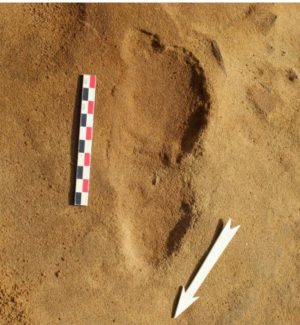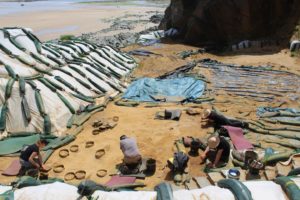Neanderthal footprints and social structure

PROCEEDINGS OF THE NATIONAL ACADEMY OF SCIENCES—A study* of 80,000-year-old footprints in Normandy, France offers a glimpse into the social structure of Neanderthals. Fossil footprints represent a snapshot in time because they are preserved only when rapidly buried. Jérémy Duveau and colleagues analyzed hundreds of 80,000-year-old fossilized hominin footprints in Normandy, France to provide a glimpse into the social structure of Neanderthals. The 257 footprints analyzed at the Le Rozel site lie in a coastal creek bed and were likely preserved by wind-driven sand when the area was part of a dune system. Though the authors did not find hominin bones at the site, they uncovered stone tools of similar age and characteristics to those found at other European Neanderthal sites. The authors note that the prints are consistent with known Neanderthal foot morphology and underscore that Neanderthals would have been the only hominin in Western Europe at the time. The documented footprint assemblage indicated a probable group size of 10 to 13 individuals. Analysis of the length and width of the prints suggested that most of the prints belonged to adolescents and children, with more children than adolescents. The youngest child was estimated to be 2 years of age. This is in contrast to the site of El Sidrón in Spain, the only other Neanderthal site that provides relatively reliable information about group composition, which showed a group consisting mostly of adults. According to the authors, the footprints at Le Rozel provide an unusual window into Neanderthal group size and composition.
____________________________

Excavation of a footprint layer on the archeological site from Le Rozel. Image courtesy of Dominique Cliquet
____________________________

One of the Neandertal footprints discovered at Le Rozel. Image courtesy of Dominique Cliquet
____________________________
Article Source: Adapted from the subject PNAS news release
*“The composition of a Neandertal social group revealed by the hominin footprints at Le Rozel (Normandy, France),” by Jérémy Duveau, Gilles Berillon, Christine Verna, Gilles Laisné, and Dominique Cliquet, published in the Proceedings of the National Academy of Sciences
If you liked this article, you may also like Laetoli: The Unfolding Story, and Footprints in the Silt, both published by Popular Archaeology.
_____________________________
See, first-hand, the original fossils. See original artifacts. See the actual sites. Talk with the famous scientists. Join us on this unique specialized study tour.
_________________________________








